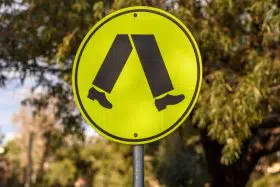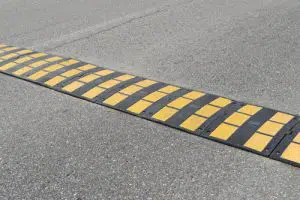
Calming traffic
In many ways, we have become a community that tends to be defined by the use of our motor vehicles. They have become a part of most of the activities that we undertake away from home. Within communities, however, there is a need for responsible use of motor vehicles. This may not always be the case and there needs to be an opportunity for residents and other responsible road users to seek ways to improve this situation. This has been recognised by many local Government authorities that will have processes to enable residents to lodge complaints that are able to be investigated and then remediation measures put in place.
Traffic calming is a system of road-related design and traffic management strategies that are intended to encourage safer, slower, and more responsible driving behaviour. It should reduce the speed of traffic, potentially reduce the volume of traffic, and encourage drivers to behave with greater awareness of the environment where they are driving.
By introducing physical design adjustments and traffic control measures, it should be possible to increase the level of safety for pedestrians, cyclists, and motor vehicle drivers. Recently, with traffic calming measures along with safety signage, Melbourne has seen many efforts to reduce the risk of accidents on residential streets, particularly in areas where there is a mix of pedestrian and vehicular traffic, as well as in car parks.
Traffic calming methods
Some traffic calming methods include reducing the lane size by allowing for on-street parking, raising intersections, raising pedestrian crossings, roundabouts, chicanes, raised central medians, extended and shaped curbing, and speed bumps.
If using on-street parking as a traffic calming method, it is important to ensure that the parking areas are clearly defined, possibly using line marking in Melbourne and textured road covering materials for clarity. Marking the roadway edge with lines and also indicating cycle lanes will assist with traffic management as well.
Road intersections
Raising road intersections forces vehicles to slow down as they approach. This will ensure that they are able to stop quickly if another vehicle is entering the intersection and they are also able to have more time to be aware of pedestrians.
Pedestrian crossings
Raising pedestrian crossings, as well as having clear road marking and signage to show the location of the crossing, will ensure that motor vehicles need to slow down as they approach the crossing. This allows them to stop easily if there is a pedestrian looking to cross the road.
Roundabouts
Roundabouts are effective for smoothing traffic flow as well as ensuring that vehicles slow down to approach an intersection. The steady flow of traffic should be achieved through a roundabout with suitable road marking to ensure vehicles are clear about where they need to give way to traffic in already in the roundabout.
Chicanes
Chicanes are used on local residential roads that are not usually used for the transit of emergency vehicles. They are made by introducing curb extensions that narrow and shape a road for a short distance so that drivers are required to slow down and drive in a snake-like pattern to pass through.
Central medians
Raised central medians will separate the lanes of traffic clearly. They potentially offer a stopping point for pedestrians who are trying to cross a road if there is traffic. They are also able to be used in association with the additional line marking to create turning lanes for motor vehicles.
Speed bumps
 Speed bumps are often used to reduce traffic speed. They are a simple but highly effective traffic control measure and there have been many developments in their construction. They can be made using road materials or concrete, and they will experience the same rate of degradation as the road surface they are on. It is important to ensure that they are constructed properly if they are going to be subjected to the movement of heavier vehicles, such as trucks. There are also alternatives that have been built using other materials, such as recycled rubber that have reflectors built into them to increase their visibility at night. Speed bumps should also be designed so that they will have minimal impact on the movement of emergency vehicles.
Speed bumps are often used to reduce traffic speed. They are a simple but highly effective traffic control measure and there have been many developments in their construction. They can be made using road materials or concrete, and they will experience the same rate of degradation as the road surface they are on. It is important to ensure that they are constructed properly if they are going to be subjected to the movement of heavier vehicles, such as trucks. There are also alternatives that have been built using other materials, such as recycled rubber that have reflectors built into them to increase their visibility at night. Speed bumps should also be designed so that they will have minimal impact on the movement of emergency vehicles.
Bollards
A bollard is usually a short metal post that is installed to act as part of the management of traffic flow. They act as an easy to see a barrier, often used to make it clear for vehicles that they are not able to drive into spaces that are away from the defined road area. They may also allow for easy access for pedestrians to be able to cross over a road space with gaps between the bollards. Some bollards have been designed so that they are able to be removed to allow vehicular access as required. They are able to come in a range of designs and colours to suit the local environment where they are installed. If they are strengthened, they become a very effective security barrier as well.
Wheel stops
Wheel stops are devices that are useful for parking control by providing a defined stopping point for a vehicle. They are able to assist motor vehicles to park correctly in a space without making contact with a building or wall that would cause damage to the vehicle and the construction. They are also able to prevent a vehicle from parking on a pedestrian walkway. These are now commonly used in commercial parking areas.
Signage
Signage is an important element in ensuring the effectiveness of traffic calming measures. It is necessary to have clear and appropriate signage to ensure that motorists are clear that they are entering into an area where these practical approaches have been introduced to reduce traffic speed and to increase the safety of residents. Safety signage in Melbourne also includes warnings about trams. Ensuring that road users have sufficient warning to adjust their driving when approaching any of these changes in the road conditions will ensure that they do not feel frustration and will abide sensibly with the driving requirements.
How mainliner can help you
If you are considering introducing road calming methods into your area, then it is important to speak to an experienced professional firm that will be able to give you clear and practical advice on what is suitable and how best to undertake the installation. Mainliner has extensive experience in selecting and installing safety signage in Melbourne, so please contact our advisors with an obligation free call on (03) 9308 2732 to get some valuable and practical advice.

